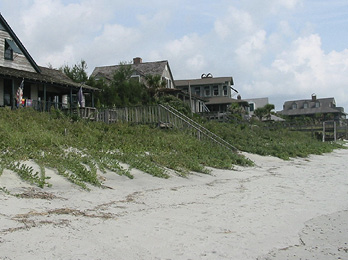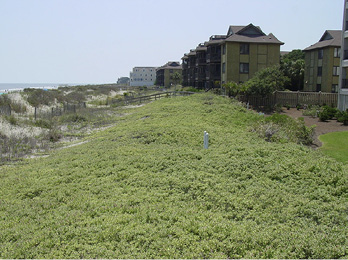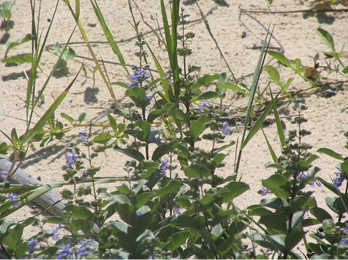Beach Vitex (Vitex rotundifolia L.f.)
Problem
Beach vitex (Vitex rotundifolia L.f.) is a deciduous woody vine that was introduced to the Southeastern U.S. from Korea in the mid-1980s. Before its introduction to the southern Atlantic Coast of the U.S., beach vitex had no history of invasiveness. However, by the mid-1990s, dune restoration specialists with the U.S. Army Corps of Engineers began to notice beach vitex spreading from original plantings on South Carolina beaches (Figure 1), crowding out native dune plants, and spreading by seeds and vegetative fragments.

The South Carolina Beach Vitex Task Force has documented beach vitex at more than 115 locations along the South Carolina coast. It also occurs along the North Carolina coast and was recently observed on a beach in Alabama. Efforts are now underway to map and monitor its spread.
Regulations
Currently, beach vitex is not regulated in the U.S. Assessments are now being conducted to determine if the plant should be regulated by federal or state plant regulatory agencies.
Description
Vegetative Growth
Beach vitex can reach 1 to 2 feet high and typically 12 feet long, but runners can grow to infinite lengths, with reports of up to 60 feet (Figure 2). Stems root along their length, forming a mat on the sand. Leaf arrangement is opposite (Figure 3). Leaves are simple, rounded, and gray-green with dense, grayish-white hairs on the lower surface. Leaves are 2 inches long and 1.5 inch wide.


Flowering
Flowers are blue-purple, fragrant, 1 inch wide, and arranged in short inflorescences out of the leaf axils (Figure 3). Fruit are round, 0.25-inch wide, and purplish-black when ripe.
Dispersal and Spread
Beach vitex is a prolific seed producer but can also spread from stem (runner) fragments (Figure 2). Seeds float and can be carried in longshore currents and waves to other beaches. Brittle stems can break off during high tides, float away, root, and colonize other beaches. In 2004, free-living plants of beach vitex were detected on North Island, a coastal barrier island near Georgetown, South Carolina, that is accessible only by boat.
Seeds and cuttings that have been chipped up and spread as mulch have also started new populations where dispersed. Beach vitex is fast-growing and drought- and salt-tolerant. Beach vitex is still sold and used as an ornamental, which is another means of dispersal.
Habitat
Currently, beach vitex blankets a number of oceanfront dunes in the Carolinas (Figures 1 and 2). Because of its invasive nature, beach vitex crowds out native dune plants such as sea oats (Uniola latifolia L.), American beachgrass (Ammophila breviligulata Fern.), and seaside panicum (Panicum hemitomon Schult.). In addition to threatening natural sand dune plant communities, beach vitex degrades endangered loggerhead sea turtle (Caretta caretta L.) nesting habitat as well as habitat for the federally threatened plant, seabeach amaranth (Amaranthus pumilus Raf.).
Distribution
The genus Vitex is not native to the lower 48 states, but several species of the genus are widely planted. Beach vitex is reported to be native to Indo-Malaysia and Hawaii, but it is found from China, Taiwan, and Japan south to Malaysia, India, Sri Lanka, Mauritius, Australia, the Pacific Islands, and Hawaii. It has escaped from cultivation in the Southeastern U.S., with free-living populations in Alabama, South Carolina, North Carolina, and Florida (suspected).
In the Midsouth, beach vitex has escaped in Alabama, and mapping efforts are underway to determine if it exists in other Midsouth states.
Control Methods
Chemical
Very little research has been done to evaluate the effectiveness of herbicides on beach vitex. The herbicides listed in Table 1 are effective for controlling a wide range of woody broadleaf and some grassy plants. These treatments may also damage other broadleaf or grass plants, including some threatened dune species, so it is important to make careful and selective applications. With all foliar treatments, a nonionic surfactant should be added to the spray solution at 1–2 quarts per 100 gallons spray solution.
Table 1. Chemical control for beach vitex.
|
Herbicide |
Formulation |
Method |
Rate |
|
fosamine |
4 lb/gal |
foliar |
192–768 oz/A or 30% solution |
|
glyphosate |
3 lb ae/gal |
foliar |
2% solution |
|
hexazinone |
2 lb/gal |
soil |
256–512 oz/A |
|
imazapyr |
2 lb ae/gal |
foliar or soil |
32–96 oz/A or 2% solution |
|
imazapyr + metsulfuron |
72.7% |
foliar |
25 oz/A |
|
metsulfuron |
60% |
foliar |
3 oz/A |
|
triclopyr |
4 lb ae/gal |
foliar |
2% solution |
Mechanical
Single plants or scattered populations of beach vitex plants should be mechanically removed from an infested site and properly disposed of to avoid unintentional spread of the plant. Digging or pulling plants manually can be used in areas where herbicide use is not desired. Plants should be removed before fruit ripening to avoid seed dispersal. Because stems can propagate through fragmentation, be careful to remove all stems and root fragments.
Physical
No physical control methods are widely used in the United States.
References
Beach vitex: South Carolina’s newest menace. 2007. South Carolina Beach Vitex Task Force.
USDA, NRCS. 2007. The PLANTS Database. National Plant Data Center, Baton Rouge, LA 70874-4490.
More Information
There are approximately 250 species of vitex ranging from temperate to tropical habitats. Beach vitex is in the mint family. A few vitex species are cultivated as woody ornamentals or for beach stabilization. Those commonly cultivated include lilac chastetree (Vitex agnus-castus L.), negundo chastetree (Vitex negundo L.), beach vitex, and simpleleaf chastetree (Vitex trifolia L.). Lilac chastetree and negundo chastetree are grown as shrubs or small trees. Beach and simpleleaf vitex have been considered a single, highly variable species (Vitex rotundifolia). However, simpleleaf vitex is upright and shrubby, while beach vitex is a prostrate, sprawling shrub (Figure 2).
The information given here is for educational purposes only. References to commercial products, trade names, or suppliers are made with the understanding that no endorsement is implied and that no discrimination against other products or suppliers is intended.
Publication 3533 (POD-04-23)
Revised by John D. Byrd Jr., PhD, Extension/Research Professor, and Victor Maddox, PhD, Senior Research Associate, Plant and Soil Sciences. Originally written by Maddox; Randy Westbrooks, PhD, former Invasive Species Specialist, U.S. Geological Survey; Byrd; and Betsy Brabson, South Carolina Beach Vitex Task Force, Georgetown, S.C.
The Mississippi State University Extension Service is working to ensure all web content is accessible to all users. If you need assistance accessing any of our content, please email the webteam or call 662-325-2262.



